Rig up some skip baits for Summer billfish action
SECTION:
MAPS:
Facts
ILLUSTRATIONS: 0
We had just travelled 26 miles from Port Stephens to the edge of the continental shelf just a few miles north of the ever-popular Carpark.
Skipper Tim Dean eased back the throttles on the Black Watch 50 Born Free and started to scan the sounder for bait schools. It took only minutes before two bait jigs were deployed to the depths and up came a dozen fat, wriggling slimy mackerel.
Immediately four healthy slimies were added to the live bait tank, while the rest were dispatched and laid evenly on the bottom of the bait fridge.
Tim shouted from the bridge that the bait was really starting tighten up, indicating that predators were in pursuit.
I quickly got to work stitching two fresh slimies to 9/0 Eagle Claw circle hooks attached to 200lb leaders, making sure that the bait was attached firmly to the hooks.
Within minutes I had two fresh skip baits ready go, which I attached to two 50lb stand-up outfits. The baits were set and the Dacron peg loops were clipped lightly to the rigger clips, the Tiagra 50Ws set in free spool with the ratchets on. It was game on!
Back in the wake of Born Free, the skip baits were happily splashing around, doing their thing in the cobalt-blue water. Tim yelled from the bridge he had just marked two fish on the sounder 30m down.
Within a heartbeat, an electric blue shadow appeared beneath the starboard rigger, its high dorsal waving frantically just above the surface – unmistakably a striped marlin.
In a flash the fish turned side on and engulfed the bait, the line tripped from the rigger and angler Norma Hocking expertly dropped the rod tip and free-spooled line to the fish.
Tim called to slowly push the drag up, the rod loaded and the circle hook found its mark.
Skip baiting isn’t a new way of targeting billfish. It has been an effective method of targeting ‘grander’ blacks in Cairns since the inception of the heavy-tackle fishery and for all species of marlin and other pelagics around the world.
Like most fishing methods it’s been refined and today is one the most exhilarating and effective ways of catching billfish.
The all-important factor to successful skip-baiting is the bait itself. In my home waters of Port Stephens we have a variety of baitfish which are ideal for skip baiting, including striped tuna, bonito, garfish and, by far the best, slimy mackerel.
It’s all about matching the hatch and as rule of thumb, the ideal baits are those found in your local waters. We have caught everything from bull mahi mahi to 360kg blue marlin on slimies.
When it comes to preparation of your bait, there is only one point to remember, fresh is best.
Don’t bother trying to freeze or brine baits, most baitfish, especially slimy mackerel, become soft once frozen and thawed. A soft, defrosted bait can mean one big sloppy mess when a fish strikes, often resulting in a missed hook-up.
If you plan a day skip-baiting then spend time catching your bait.
A typical day on Born Free begins by scanning the sounder for bait schools and, once located, two Black Pete Super Jigs are deployed with a 4oz snapper lead attached to each.
We use 20lb to 30lb spin rods around 7’ long with Shimano Stradic 8000 reels loaded with 30lb braid. These are ideal for the job and can make life easy when dragging up bait from 50m down all day.
They can also handle the heat when an energetic black or striped marlin decides that a string of half a dozen slimies is an easy meal.
Once you have caught your fresh slimies, make sure that you keep them cool. I always lay them flat in a large plastic container with a wet cloth laid over to keep the baits moist, then simply pop them in the bait fridge or esky.
Remember to use saltwater when keeping the baits moist, use freshwater and your baits will become soft during the day.
Now it’s time for rigging. Rigging doesn’t have to be complicated, in fact the more simple the rig, the better.
There are probably 100 ways to rig skip baits but one I have learnt is a simple and effective method is ideal for circle hooks.
Everybody should know by now that circle hooks are the way to go for catch-and-release fishing because they almost inevitably end up in the corner of a fish’s mouth and stick there without any trickery from the angler. Gut-hooking just doesn’t seem to happen.
All you will need is 50lb waxed Dacron, 1/8” plastic hydraulic tubing, quality stainless steel bait-rigging needles and circle hooks.
When it comes to circle hooks it really comes down to personal preference, but all will work with this type of rigging.
Leader material is also something of a personal preference. Of course, like any fishing, the lighter the better.
I find 200lb to 250lb ideal when fishing the edge of the shelf, while in inshore waters targeting smaller blacks, 100lb to 150lb will suffice. But when those larger blue marlin turn up, 400lb leader is required.
Take about 60cm of 50lb waxed Dacron and half-hitch over the bend of the hook. Make sure that the two ends are even.
Then simply slide 25mm of tubing so it sits snug against the hook, making sure it’s firmly in place by simply placing an overhand knot at the end.
Place one end of the Dacron through a rigging needle and pass it through the centre of the bait just in front of the eyes, making sure it is dead centre in line with the nose. Push through so it exits underneath the chin of the bait.
With the other end of the Dacron, repeat this process but start from underneath the chin, exiting at the top the head in front of the eyes, basically at the same line of the first stitch.
Now tie a double overhand knot to the side of the bait, making sure that the tubing is exactly dead centre and nice and firm against the mouth of the bait as shown.
Make a cross stich at the top of the head by simply passing both ends of the Dacron opposite each other just above the eye socket and, once again, tie with a firm double overhand knot at the top of the head.
Cross-stitch just above the bottom of the gills and tie a double overhand knot at the bottom of the gills so that no water can penetrate and cause the bait to spin or fill with water.
Now trim any excess Dacron and your skip bait is ready.
With this simple method there is no need to gut and gill the bait or even cross-stich the stomach or back.
Fresh baits should last a couple of hours before replacing.
With less stitching and less thread in the bait, I believe it makes it much easier for a fish to swallow, especially billfish with their rough bills and mouths.
Now you have your skip baits ready to go, it’s time for action.
My technique is simple: two baits positioned in the outriggers, one short, one long, at a trolling speed of around 3 to 6 knots, depending on the conditions.
Too many baits and you will find that you will have too many complications.
You will be surprised at the fish-raising capabilities of two well-presented skip baits splashing about on the surface.
If you feel the need to add a teaser then keep it simple as well. Either a soft-headed hookless lure such as a Moldcraft or Zacattack are ideal, or even a daisy chain of four to six large Moldcraft squid work well.
When it comes to rods and reels, I will leave that to you. Both stand-up and chair rods can be used, as well as light and heavy tackle.
The most important tips to remember are to have the outrigger clips tensioned as light as possible, leave the reels in free spool with the ratchet on and the angler ready to free-spool line the moment the it trips from the rigger.
Remember, with circle hooks it’s a slow ease of pressure to set the hook. Slowly push the drag up and when you start to feel pressure, gently lift the rod.
It’s hard to keep calm with all the mayhem but a good skipper and crew should guide the angler through the process.
So there you have a simple skip-baiting rig that is uncomplicated and effective. You may even refine your own technique.
Either way, skip-baiting is a visual and exhilarating way of catching billfish and now is the perfect time to get out there and give it go!
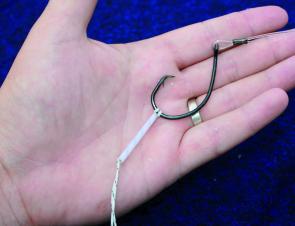
Take 60cm of 50lb Dacron, half-hitch over the hook and slide on the tubing.

A grand slam of all three marlin species, all caught on skip baits.
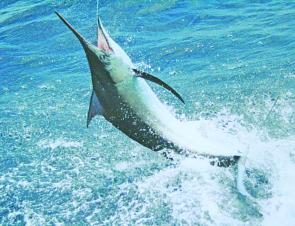
Skip-baiting has been used on billfish for decades – because it works.

Pass one end of the Dacron down through the centre of the head and out through the chin, the other from down to up, then snug up the tube and tie.
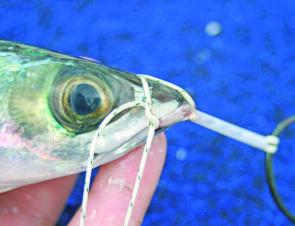
tie a double overhand knot to the side of the bait

Make a cross-stitch at the top of the head and tie off.

Cross-stitch just above the bottom of the gills and tie a double overhand knot at the bottom of the gills and trim.

Ready for action.
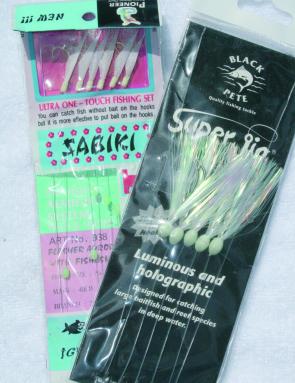
Make sure you have a good supply of quality bait jigs.
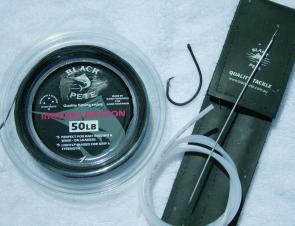
Tools of the trade: Waxed Dacron, plastic tubing and quality bait needles.
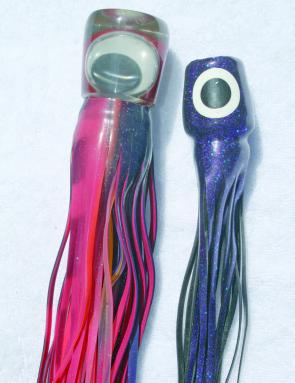
Softhead pusher lures make great teasers when skip-baiting.




